This story / page is available in:
![]() German
German
John O’Donohue, Irish philosopher, poet and best-selling author. Who was the man behind the well-known public figure? Part 10 and end of the decalogy about a rich life that ended abruptly.
In June 2021, I travelled back to Connemara. I wanted to meet people who knew John O’Donohue well, who were friends with him, who knew who he was – the person behind the public figure.
I travelled from Galway via Spiddal towards Rossaveal, where John had worked as a young priest. Where does the Connemara beginn, that I was so fond of? The money from Galway and Dublin eats ever deeper westwards into the old loneliness of the rugged landscape that John had loved so much. The new Ireland is carelessly sweeping aside the old Ireland in many places. Bulldozers and excavators turn millennia-old farmland into villa land in the blink of an eye. Ireland is reinventing itself – in disruptions, without continuity. Money is now God, consumption the new religion. Property is king.
Support our writing: YOUR DONATION is much appreciated.
The Good Friend, fully confidential
In Screebe House, a beautiful old country hotel in Rosmuc, past and future meet in the moment. On Zoom I talk to one of John O’Donohue’s best friends. He has been dealing with the abrupt death of his friend in a long creative process. We bridge decades and continents with Zoom. The man knows a lot, tells a lot, but it all has to remain confidential for now. That was the rule of the game.
The next day I visit the old house where John had lived for many years (more details about the old cottage here). It seems even more deserted now than it did last autumn. At the front door, through which hardly anyone has passed in the past 13 years, the herbage grows tall. This place has no present. In the end, nature will take it all back.
Visiting HR und Heidi Hebeisen on the Island
On an island in one of Connemara’s many lakes, the Hebeisens spend the summer in their historic country house. Here, to this gem of an exotic garden on the island, John often came to meet his friends Hans-Ruedi (HR) and Heidi. Often on his own, sometimes with a partner. They fished together, dined and drank together, had long philosophical conversations. They shared a love for Connemara, for good food, first-class wines, fine clothes and deep conversation.
HR and Heidi invited me to the island to talk about John. HR remembers well his last meeting with John in November 2007. He took some photos of him on the sidelines of a filming project, they arranged to meet during the Christmas Holidays. John then cancelled the meeting at short notice and, according to Hans-Ruedi’s impression, left for France unscheduled and in a hurry.
Heidi says John was under a lot of pressure at that time. He longed for a normal life, wanted to get out of public life. In the new year, another reading tour in America was on the agenda: “John didn’t want to go to America, but he felt he had to, as he had promised.”
Part 10 of the Ireland News series on John O’Donohue
- Click here for the overview: All articles about the life and work of John O’Donohue.
- Click here for the book list: The books of John O’Donohue.
Heidi feels that John had not been a happy person of late. The role of guru to a needy, esoteric following had not suited him, she says: “John had opened Pandora’s box and now found himself thrust into a role he didn’t want. He wanted to go back to his original existence.”
We are talking about the man John O’Donohue, the priest and ex-priest who said of himself that he had never been celibate. The Hebeisens knew that John had numerous partners. Heidi says:
“John was a man for the community. He belonged to all women. He was not made for a two-partner relationship”.
Heidi remembers walks with John, how he would naturally put his arm around her shoulder as they walked together.
“He was not afraid of physical closeness and touch. He also used touch purposefully to express his sentences and communication.”
On his last visit, John was musing about a new book project: he wanted to write about the colour red . . .
An Interview with Dara Molloy
Back in Spiddal. A Friday morning in June. I meet the Celtic priest and celebrant Dara Molloy. We sit down for a long chat. He has come to the mainland early from his home on the Aran island of Inis Mor.
Dara and John met and became friends in 1985. John then worked as a young Catholic priest in Rossaveal, Dara was a Catholic priest living as a Celtic hermit on Inis Mor. Dara would visit John at his house near the ferry terminal before catching the boat back to the island of Inis Mor.
Dara’s future wife Tess Harper was in John´s orbit even earlier. She too had studied Catholic theology at the Maynooth seminary. John then was a few years ahead of her. When Dara talks about John today, he often quotes Tess, who perceived their mutual friend from a different perspective. About John’s sudden death in early January 2008, Dara says: „I was in utter shock when John died. On TG4 I was asked to comment about John´s life and said: ‚We were like brothers‘. The reason I felt we were like brothers was that we had both removed ourselves from Roman Catholicism, and we were both rooted in Celtic spirituality. When we first met, we were both active Roman Catholic priests, so each of us made a similar journey out of the Church.“ This is the interview I did with Dara:
John gave up the priesthood after many conflicts with the Catholic Church, but his departure was very quiet . . .
Dara Molloy: John slipped away from the Roman Catholic Church, he was never clear about it. He left it wooly. I left the church too. At the end of my last Catholic Mass on Inis Mor I announced that I am leaving Church and will remain a priest to refound the Celtic Church. The bishop saw this as a threat. All the parish priests were told not to allow me into churches any more. This was the news talk in the Irish media for three days in 1996.
John never did anything of the sort. Therefore, as soon as he died the church reclaimed John, as he had not made a clear-cut exit. I was so angry when I saw the funeral with all the priests and bishops.
Did he ever get over this separation?
Dara: His conflict with the church was not resolved.
What development do you see in John’s books, Dara?
John’s early writings were catholic. They changed to universal, they became inclusive and were not confined by Catholic doctrine. He discovered where the larger audience was. The two books after Anam Cara were forced on him by his US publishers and massive advance payments. In my view, these two books do not contain the same magic as Anam Chara. Benedictus, his last book during his lifetime, was the real John again. John was a voice on our way into the noosphere.¹
Who was the man behind the well-known public figure?
John had his strong external persona and his hidden private side. We never saw his private side. He didn’t show it. We loved John, we loved the wonderful conversations. But I think maybe he did not like intimate conversations. Ideas yes, intimacy no.
John was known for his loud, thunderous laugh . . .
I think, his loud laugh was covering up something. John’s mother did not like this loud laugh. It was possibly part of his public persona.
- Click here for the overview: All articles about the life and work of John O’Donohue.
- Click here for the book list: The books of John O’Donohue.
- Copyright: © Markus Bäuchle 2021. All rights reserved.
Was John O’Donohue a happy man?
No, I don’t think so. He was much more fulfilled in his writings and lectures than he was as a Catholic priest. Unhappy is not the correct word. But certainly he was not fulfilled. He had not arrived where he wanted to be. He did not feel comfortable as a celebrity, and he was constantly seeking the right partner.
Why not fullfilled?
John was hungry for a relationship. He yearned for it. He had a hunger for it. He went for so many women. He did not find it. We thought he was not made for a love relationship. We hoped for him he would find what he yearned for. John came out of many relationships when he met Kristine. We hoped very much for him things would go well now.
John also felt very uncomfortable being famous. When asked for doing a TV-series for RTE, he would not do it. It was done by John Moriarty finally. He very rarely took to Irish TV. The exception was the fight for Mullaghmore. John was uncomfortable with his fame. He was a guru, he was treated as a guru. He was invited to celebritiy weddings, just as he was a guru. The US publishers had dragged him into it. He had to deliver books, give lectures, tour.
So he wanted to fundamentally change his life in the winter of 2007/2008?
John was in a transition moment in his life. He told me he intended to finish with his public life and become a scholar again. He wanted a private life. He was very vulnerable in that deep transition moment.“
The sudden death on 3 January 2008 prevented a new beginning. Before we parted ways, Dara and I discussed, whether John O`Donohue, the gifted language artist, writer and speaker, was a native Irish speaker, as mentioned in his official curriculum vitae and in part 2 of this series. His official website reads: „John O’Donohue was born in 1956, into a native Gaelic speaking family“. Dara was pointing out that John learned his excellent Irish in school as most students in the Sixties: „I think the family did not speak Irish“.
Back home I checked the Irish census of 1901 and 1911. Dara was rigt: John´s father and his siblings grew up with English and only learned Irish later. John was very talented with language: Within four years in Germany he learned to speak and write the German language in a manner most Germans would have been proud of. Even at a young age, he had learned Irish like a mother tongue at school.
At Patrick McCormack´s Farm in the Burren
On the way back to the South West, I visited farmer and poet Patrick McCormack in the Burren in County Clare (a report on the visit can be found here). We talked at length about the worrying state of the natural world and where hope for the future would come from. John’s long-time friend, who together with him won the ten-year battle against the tourism centre at the Burren’s Mullaghmore mountain, also spoke about the all-too-early departed:
Above all John spent his short life dilligently tracking the spiritual impulse.
„John did not follow the path of the roleplayer, he was someone who broke the mold.He was always aware of the cosmic Christ.
There was no narrowness in his generosity.
He embraced the world and was all too generous.He had no boundaries, he exhausted himself.“
Fighting with Lelia Doolan
Finally I met John’s trusted companion Lelia Doolan, a grande dame of Irish cultural life. She is a woman of the first hour in the young Irish television station RTE, she made and she produced TV series and films, she wrote, she gave speeches, she stood up for LGBT rights, she directed the Abbey Theatre and fought against the destruction of nature in the Burren and against the Corrib Gas project.
Lelia also fought with me. The energetic 86-year-old woman questioned whether information about John O’Donohue’s life was of any relevance or interest at all. The work was everything, Lelia Doolan postulated. A person’s ideas count, not his private life. After all she gave me some brief insights about her long and precious friendship with John. From our conversation in her neat cottage by the sea in the south of County Galway, she authorised a sentence of which it should remain fascinatingly unclear whether the qualities described referred to John’s farewell to the church, his farewells from relationships or his farewell to this life:
„Like the Tuatha de Danann, he could turn sideways into the light and disappear.“
Anyway, on the tombstone of the O’Donohues’ family grave at Fanore in County Clare these words are engraved: „Their lives have changed, not ended.“
At the End of the Journey: New Questions
This journey has taken me to fascinating places and interesting people. I have read many books, watched old videos and listened to hours of audio files. I have spoken to numerous people who knew John – and it was those who had been closest to him who were least likely to talk about him. They built a wall of silence around the legacy of the man to probably prevent its interpretation by others.
At the end of this search for clues are some questions that would not have occurred to me at the beginning of the journey:
* Was John a lonely person? Did he remain a seeker or did he find what he was looking for?
* Was he made for the love he described so deeply and so eloquently, and for a loving partnership?
* Could he ever cope with the separation from the church as his spiritual home? Did he ever cease to be a Catholic cleric at heart?
* How coherent was John with himself and with what he published as his ‘philosophy of life’?
* Was John O’Donohue a happy man?
On John O’Donohue, writer, poet, priest
John O’Donohue (1956 – 2008), grew up on a farm in a limestone valley in the Burren, County Clare. The eldest of four siblings, he became a priest, later a writer, philosopher and poet, environmental activist, life teacher, speaker, mystic and humanist. With Anam Cara, The Four Elements (published and available in German by dtv), Eternal Echoes and Divine Beauty he wrote international bestsellers. He loved human existence in all its facets. His great theme was to live life to the fullest without fear. He considered unlived life to be the maximum transgression of being human. In books and lectures, John encouraged people to courageously live the life they wanted and would love. It was important, not only to dream one’s dreams but also to realise them and thus find one’s destiny – free from fear and straight from the heart.
O’Donohue was a free spirit who thought Celtic as well as Christian spirituality, the mysticism of Eckhart and the philosophy of Hegel. He saw us, the living, walking on the shore of the great sea of the invisible, the imagination creating the bridges from the visible to the invisible world. He understood the deep human longing for belonging in an increasingly meaningless material world and was convinced, that human beings can overcome the fear of death – because it is a progress, not an end. His headstone reads, “Their lives have changed not ended.”
I often think of this man who taught me a lot about life, the soul, Celtic spirituality, nature. I never met him, I read his books. How often I heard his words about the soulful landscape when I walked through the rocky bog. Felt his wisdom when I moved through the mountains, understood his deep unity with nature when I stood by the sea and looked west. On 1 January 2021, John O’Donohue would have turned 65, had he not died unexpectedly 13 years ago. I would have loved to have met him. In November 2018, I started researching John’s life. It began by chance at his grave in Fanore in County Clare. I reported on the results of this search from January to October 2021 here on Irlandnews. The series ends here with part 10.
You can support our work with a donation
References and Photo-Credits
- ¹ This is Dara Molloy´s reference to the writings and thought of the Jesuit Pierre Teilhard de Chardin who spoke of the earth evolving, with the help of humans, towards the ‘Noosphere’ or a collective universal brain (in the way flocks of birds act as one, so humans will act as one). John never mentioned Teilhard, to Dara´s knowledge, in his writings.
- Many thanks to Meinhard Schmidt-Degenhard for inspiring questions.
- Photos in this article, unless otherwise stated in the photo credit: Markus Bäuchle
- I would like to thank the Hessischer Rundfunk (hr), Hans-Ruedi und Heidi Hebeisen and Pip Wilson for the provision of the photos.
- Black and white portrait of John O’Donohue: dtv.
This story / page is available in:
![]() German
German




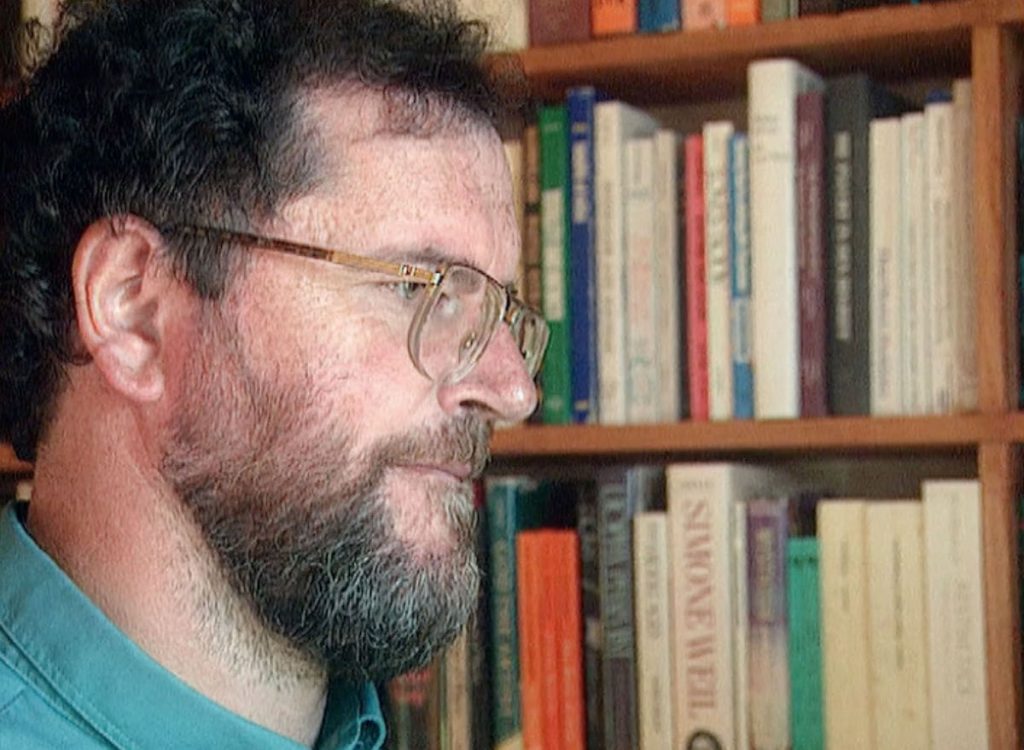


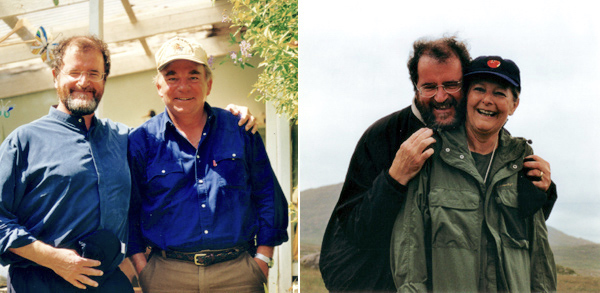
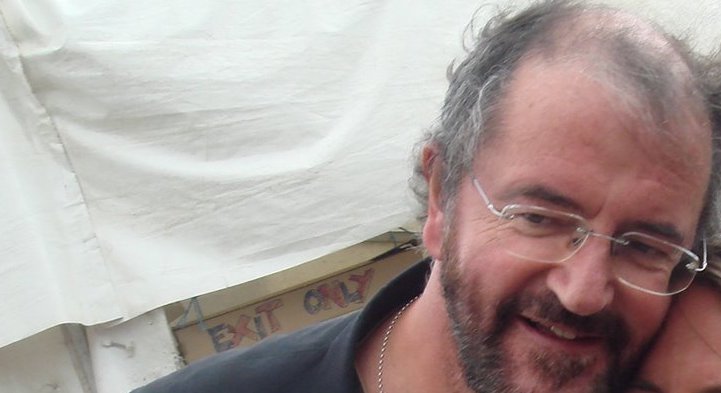




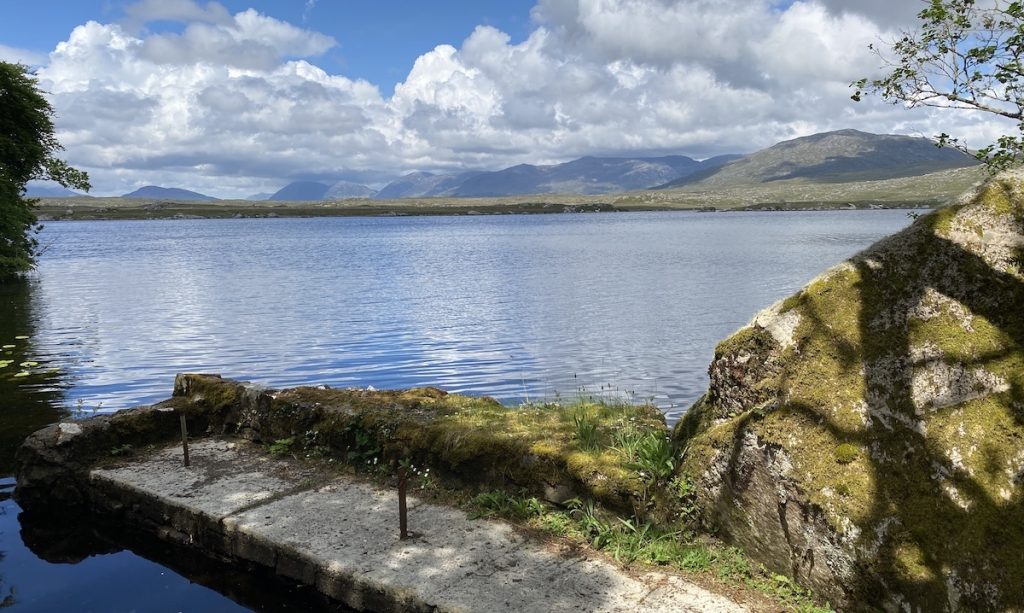

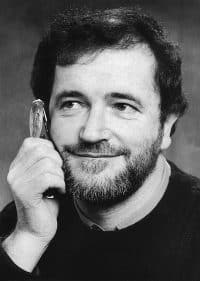
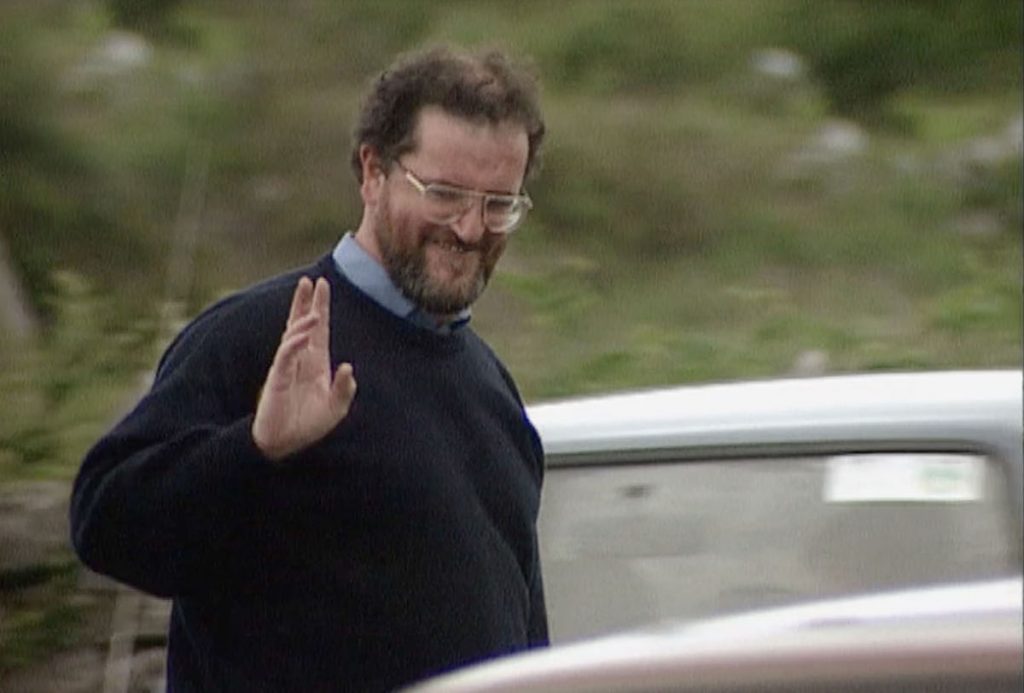
I just discovered your article series on John O’Donohue and really, really enjoyed it. Like you I never met him in person, but loved his book ‘Anam Cara’ at the time. To this day, I am finding his work very inspirational, since I am realising, that there’s too much superficial spirituality junk food out there. He was one of the few deep thinkers, that embraced paradox and really spoke the language of the soul so eloquently. It was great to find out a bit more about him as a person, I think you were very respectful and did an excellent job. Thank your for this!
I also found John inspirational. His book Echos of Eternity helped me when I experienced loss and grief. I would have loved to meet him.
At least we have his books. I often wonder if he found the peace he so much longed for in eternity.
Hello Markus,
Thank you for all you have shared about the beloved writer and poet, John O’Donohue.
In the years since you wrote this, have you discovered anything more about him? It would be interesting to know.
Thank you!
Markus thank you so much for your research and insights into John O’Donohue’s life. Through his wonderful legacy, he remains with us.
Thank you for your research into the life of this great poet and philosopher. I have read your posts and if you gain any more info., please continue sharing.
Thank you Susan, I will. Markus
Danke für diese vielschichtige Serie über einen vielschichtigen Menschen. Es war sehr interessant, man liest seine Bücher jetzt nochmal anders.